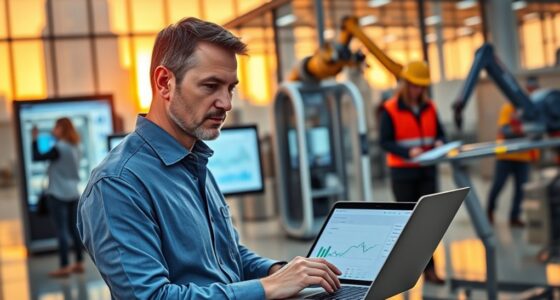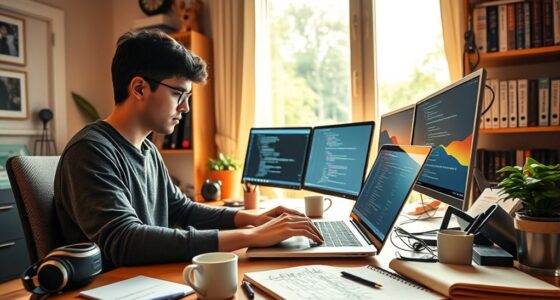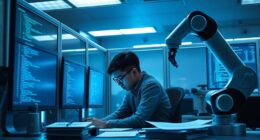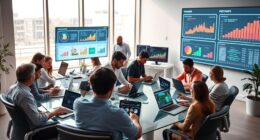AI is revolutionizing how artists and writers collaborate with technology, serving as both a creative partner and a tool. It helps generate music, visuals, and written content faster, opening new avenues for experimentation. By blending human intuition with machine learning, creators can push artistic boundaries and produce more diverse, innovative work. As these collaborations grow, ethical questions and challenges arise, but ongoing advancements continue to unleash exciting possibilities—if you stay curious, you’ll discover more behind this evolving partnership.
Key Takeaways
- Artists and writers leverage AI as a collaborative partner to explore new styles, experiment rapidly, and blend human intuition with machine-generated ideas.
- AI tools streamline creative workflows, increasing productivity, enabling faster content production, and expanding possibilities across visual, musical, and literary media.
- Hybrid human-AI collaborations foster innovative projects, challenging traditional notions of authorship and expanding artistic boundaries.
- Creators use AI-driven platforms for brainstorming, drafting, editing, and refining, enhancing efficiency and creative output.
- Ethical considerations and transparency are integral as artists and writers navigate authorship rights and authenticity in AI-assisted works.
The Rise of AI in Artistic Expression

The rise of AI in artistic expression is transforming how we create and experience art. By 2025, AI-generated art is expected to make up 5% of the contemporary art market, showing its growing influence. Nearly a third of Americans have seen AI art, even if many don’t realize it, indicating widespread exposure. Art exhibitions featuring AI works have increased by 25% over three years, reflecting rising acceptance. However, artists express concerns about outdated copyright laws, with 89% feeling current regulations don’t fit AI art. The global art market faced a 12% decline in total sales in 2024, yet advancements in AI technology continue to push creative boundaries, offering new ways to innovate. Despite ongoing debates about its artistic value and legal issues, AI’s role in art is expanding, shaping a new landscape for creators and audiences alike, especially as digital creativity tools become more accessible to artists worldwide. Additionally, the integration of AI has opened up new collaborative opportunities between human artists and machines, fostering innovative artistic partnerships, which are often supported by self-generating algorithms. Furthermore, the integration of personal development techniques such as mindfulness and visualization is influencing how artists approach creativity, blending mental well-being with artistic innovation.
Transforming Music Creation With Artificial Intelligence

Artificial intelligence is revolutionizing how music is created, making it more accessible and innovative than ever before. The AI music market is projected to grow from $3.9 billion to $38.7 billion by 2033, boosting overall industry revenue by 17.2% by 2025. This growth democratizes music production, enabling you to compose, record, and produce from home, regardless of your technical skills. AI-powered tools assist with melody, harmony, and sound design, mimicking genres and even artists’ voices. As automation increases, traditional roles like producers and composers may shift, risking income loss for some. However, AI also offers new opportunities for independent creators to innovate and control their work, transforming how music is made and experienced. Utilizing songwriting tools powered by AI technology, artists can now experiment with complex compositions that would have previously required extensive resources, and incorporating wall organization solutions can help create inspiring creative spaces at home. Additionally, integrating space-saving storage strategies can help keep these creative environments clutter-free, fostering better focus and inspiration, and understanding industry trends can help artists stay ahead in this evolving landscape. Moreover, advancements in home studio equipment allow creators to produce professional-quality music without expensive studio rentals.
Visual Art Revolution: AI as a Creative Partner
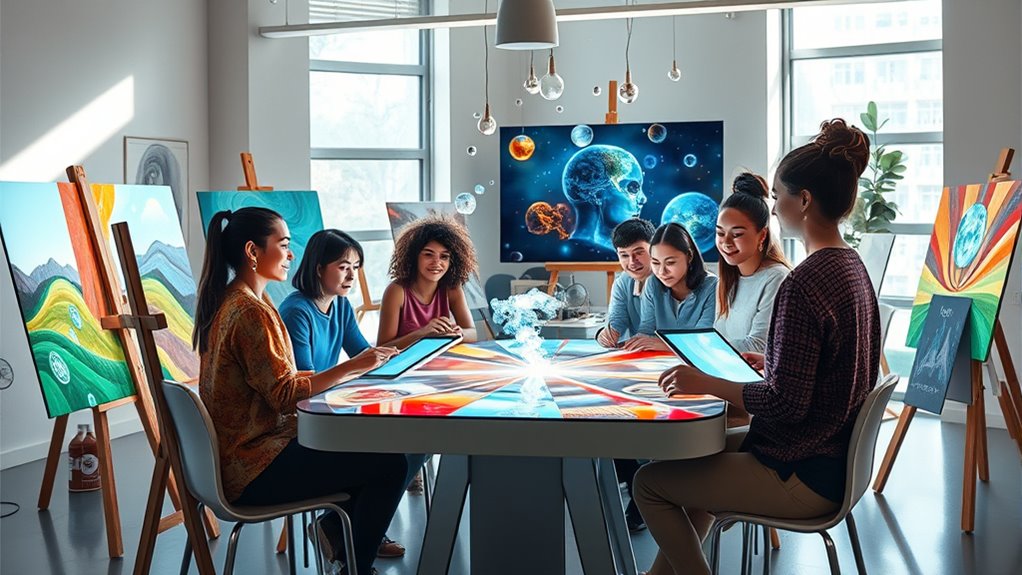
AI is transforming how you create and experience visual art, acting as a powerful partner in the artistic process. As boundaries between human and machine blur, new ethical and artistic challenges emerge that you need to contemplate. This revolution prompts you to rethink traditional notions of authorship and originality while exploring innovative ways to express your vision. Recognizing the importance of empathy and active listening in collaboration, artists are increasingly incorporating AI to foster deeper connections with their audience. Additionally, tools like unique and wicked planters exemplify how creativity can extend beyond traditional art forms, inspiring new ways to engage with design and functionality. Incorporating Honda tuning techniques can inspire artists and designers to experiment with customization and performance enhancements in their creative projects. Furthermore, understanding essential oils can open new sensory dimensions in experiential art installations, enriching audience engagement. Exploring rustic lighting and vintage furniture can also add authentic character to your artistic environment, enhancing the overall experience.
AI’s Role in Art Creation
As technology advances, artists increasingly see AI as a collaborative partner rather than just a tool, transforming how they create and experiment with visuals. AI enables rapid exploration of new styles, blending human intuition with machine-generated concepts. The market is growing fast: it’s projected to reach $8.6 billion by 2033, driven by adoption across entertainment, media, and design sectors. Cloud-based platforms make AI tools accessible worldwide, and innovations in high-resolution generation and AR integration expand creative possibilities. Here’s a snapshot: Market Growth Rapid expansion, reaching $2.51B by 2029. Additionally, with approximately 1 in 3 organizations currently using AI, the adoption rate among artists and creatives is expected to continue rising sharply. | Aspect | Impact |
| ——— | ——— |
|---|---|
| Market Growth | Rapid expansion, reaching $2.51B by 2029 |
| Adoption | 40% of users are artists and creatives |
| Applications | From social media to fine arts |
AI empowers you to push artistic boundaries and experiment more than ever before.
Blurring Human-AI Boundaries
The evolution of technology is reshaping how artists approach their craft, especially as the boundaries between human creativity and machine-generated work become increasingly blurred. You see AI being integrated into traditional art forms, opening up new mediums and techniques for experimentation. Collaborative projects between artists and AI systems produce unique pieces that combine human vision with machine capabilities. This fusion is impacting the art market, with AI-generated works gaining recognition through sales and exhibitions, while the technology itself becomes more sophisticated. AI also drives artistic innovation, enabling artists to explore diverse styles and concepts effortlessly. As online communities grow, so does engagement, fostering collaboration and experimentation. Ultimately, AI is transforming visual art into a dynamic, hybrid space where human and machine creativity intersect seamlessly. AI’s role in art education is expanding, prompting educators to rethink traditional methods and incorporate creative practice with AI support responsibly. Additionally, understanding how art market develops with AI support can help artists refine their skills and expand their creative horizons. Furthermore, the integration of AI tools into professional art environments is increasingly common, offering new opportunities and challenges for artists and institutions alike. The ongoing development of AI-driven tools continues to push the boundaries of what is possible in art creation and appreciation.
Ethical and Artistic Challenges
While AI opens exciting new possibilities in art, it also raises significant ethical and artistic challenges that can’t be ignored. You might struggle with questions of authorship and ownership, as current laws don’t recognize non-human creators, leaving legal gray areas. The originality of AI-generated works can be questioned, challenging traditional ideas of authenticity. Additionally, AI often trains on existing artworks without artists’ consent, raising issues of intellectual property theft and unfair compensation. Economically, AI could devalue human art and shift market dynamics, risking job displacement. Artistically, AI may lack the emotional depth and conceptual nuance that define human creativity, potentially diluting the artistic process. Legal frameworks balancing these challenges is essential to ensure AI enhances rather than undermines the integrity and value of art.
Enhancing Writing Processes Through AI Tools

AI tools are transforming how writers approach their craft by streamlining tasks and boosting productivity. With 78% of U.S. organizations actively using these tools, you can see how widespread adoption is. They enable 59% faster content creation and increase output volumes by 77%, helping you produce more efficiently. These tools assist in brainstorming, drafting, editing, and proofreading—saving time and reducing errors. As over 70% of organizations integrate AI into workflows, you’ll find AI becoming integral to content strategies across industries. The market continues to grow, with investments rising and the U.S. remaining a leader. Embracing AI allows you to develop new skills, enhance creativity, and stay competitive in a rapidly evolving environment.
- Streamlining content workflows for efficiency
- Boosting output and reducing production time
- Supporting idea generation and editing processes
- Facilitating skill development and creativity
Collaborative Dynamics Between Humans and AI
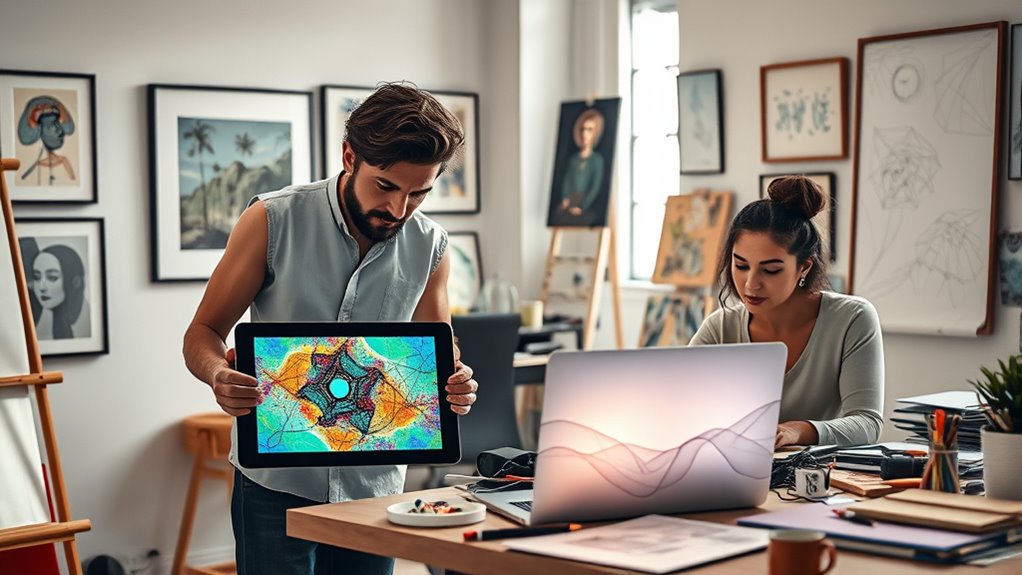
You’re at the forefront of human-AI collaboration, where synergy enhances creativity and pushes boundaries. As AI handles repetitive tasks and offers new ideas, your nuanced judgment and emotional insight remain essential. Balancing these roles creates works that neither humans nor machines could achieve alone. Platforms like SmythOS facilitate seamless integration of AI workflows, further empowering creators to innovate. Recognizing the importance of emotional support in collaborative environments can foster trust and inspire more meaningful creative partnerships. Leveraging AI content clusters allows artists and writers to organize and refine their ideas more effectively, leading to deeper audience engagement. Additionally, implementing payment security measures can help protect digital assets and foster trust in online collaborative platforms. Incorporating holistic health benefits from practices like yoga can enhance creators’ mental clarity and emotional resilience, enriching the creative process.
Human-AI Synergy
The collaboration between humans and AI has transformed creative practices by combining computational power with human intuition and emotional insight. This synergy allows you to leverage AI’s ability to process vast data and generate diverse options quickly. Meanwhile, your nuanced understanding and aesthetic judgment add depth and authenticity to the work. Together, you can push creative boundaries and produce innovative results that neither could achieve alone. By embracing this partnership, you benefit from enhanced productivity and expanded creative possibilities.
- AI acts as a rapid ideation engine, offering numerous variations.
- Human insight refines and contextualizes AI-generated outputs.
- The collaboration fosters novel artistic genres and media formats.
- Trust and understanding deepen as both sides recognize each other’s strengths.
Creative Role Balance
Balancing creative roles in human-AI collaboration involves clearly defining each participant’s responsibilities to maximize efficiency and artistic quality. You handle nuanced, conceptual, and emotional aspects, while AI manages repetitive or data-heavy tasks. Effective prompt engineering is essential; over half of artists say they contribute mainly through prompts. Most maintain control over the final work, with around 39% feeling their input is minimal but essential. Control varies based on project preferences, with some using AI as a rough draft tool, others as a true collaborator. This dynamic fosters faster iteration and interdisciplinary cooperation but raises questions about credit and ownership. Understanding these roles helps you navigate the evolving landscape of hybrid creativity:
| Role | Human | AI | Shared |
|---|---|---|---|
| Responsibility | Creativity & Ethics | Data Tasks | Collaboration |
| Control | High | Limited | Variable |
| Influence | Strong | Support | Co-creative |
| Focus | Nuance & Emotion | Routine Tasks | Balance |
| Outcome | Artistic Vision | Efficiency | Hybrid Art |
Ethical and Artistic Considerations in AI-Generated Content
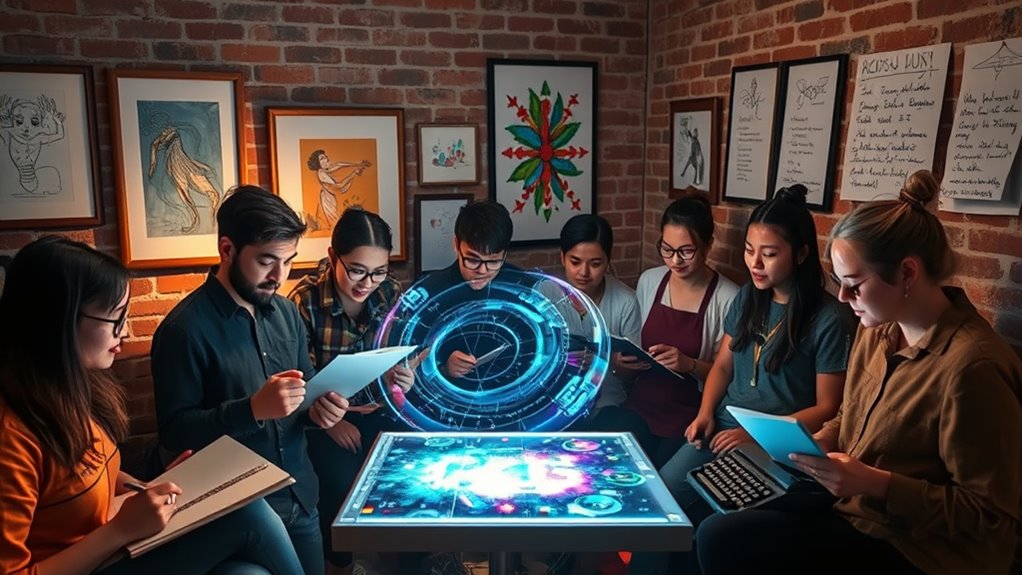
How do artists and writers steer the complex ethical and artistic questions raised by AI-generated content? You must consider ownership rights, as claims can come from both AI developers and prompt creators. Copyright infringement is another concern, especially when AI replicates protected elements without attribution. Biases in AI outputs can perpetuate stereotypes, challenging the integrity of the work. Transparency about how content is produced and data used is essential for accountability.
Artists and writers must navigate ownership, bias, and transparency in AI-generated content.
Key considerations include:
- Clarifying ownership and copyright boundaries
- Addressing biases and ensuring fair representation
- Balancing human creativity with AI assistance
- Navigating cultural and social impacts of AI art
These factors shape how you ethically and artistically incorporate AI into your creative process.
Challenges Facing Creative Industries With AI Integration
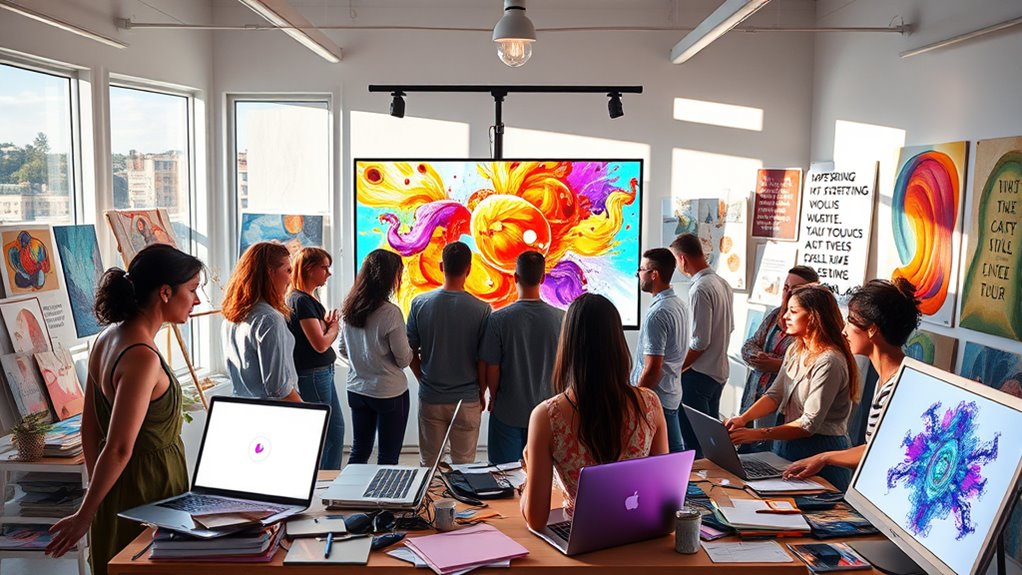
As AI continues to reshape creative industries, professionals face significant challenges in adapting to rapid technological shifts. Market disruption is rapid; AI-generated content is booming, with markets like AI images projected to hit $60.8B by 2030. This growth leads to job displacement, as traditional roles in design and writing become less secure, requiring upskilling to stay competitive. Intellectual property laws lag behind AI advancements, causing disputes over ownership and authenticity, making galleries hesitant to acquire AI art. Content overload due to accelerated production strains platforms and diminishes originality, while concerns about quality and emotional depth grow. As AI saturates markets, standing out becomes harder, and the risk of homogenization increases. Steering through these challenges demands agility, ongoing learning, and clarity on legal and ethical standards.
Future Trends in AI-Driven Creativity

The future of AI-driven creativity is set to expand rapidly, transforming how artists, writers, and designers work. Expect more sophisticated generative models that push the boundaries of artistic expression and automation, allowing you to focus on storytelling and innovation. As AI tools become more advanced, you’ll see new opportunities for hybrid human-AI collaboration, making complex projects more accessible. The rise of AI-created virtual influencers will reshape marketing and engagement strategies, especially among younger audiences. Additionally, AI-powered social shopping will enhance e-commerce, blending content with seamless purchasing experiences. This evolution will further democratize content creation, lowering barriers and fostering diverse voices across creative fields. Overall, AI’s role in shaping future creative landscapes promises increased efficiency, originality, and inclusivity.
Embracing Innovation: Opportunities for Artists and Writers
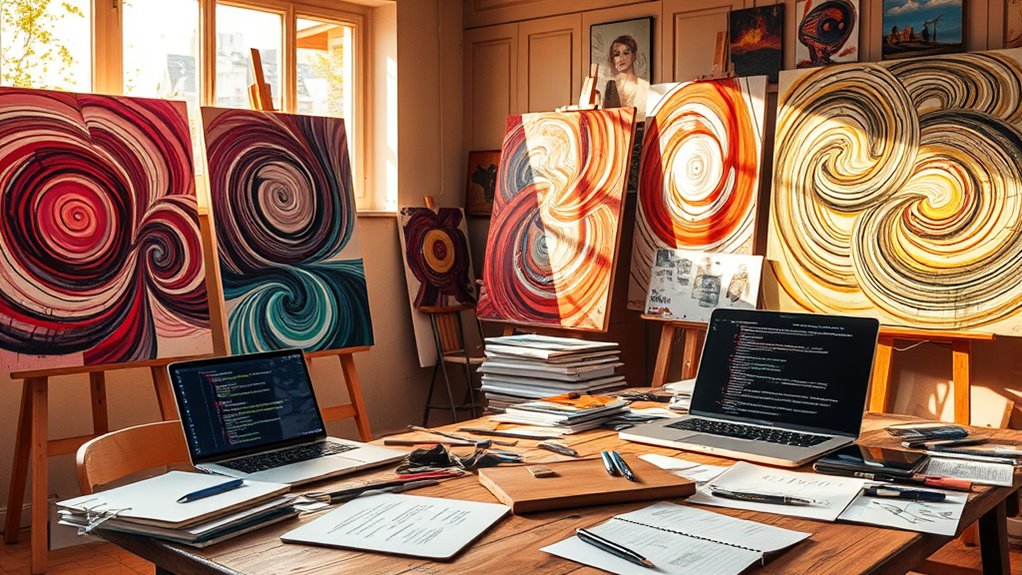
Embracing innovation through AI opens up exciting opportunities for artists and writers to enhance their creative workflows and push boundaries. AI tools help you produce content up to 59% faster and reduce the time spent on projects by up to 30%. With AI-assisted processes, you can generate a higher volume of work—77% more—allowing for more experimentation and diversification. These tools automate repetitive tasks, freeing you to focus on higher-level creative decisions. They also expand your creative palette, enabling mixed-media art, innovative storytelling, and enhanced visual effects. Widespread adoption across industries means you’re part of a global movement, improving audience engagement and market reach. AI democratizes access, making powerful tools affordable and user-friendly, so you can innovate regardless of your experience level.
Frequently Asked Questions
How Do Artists Maintain Originality When Using AI in Their Work?
You can maintain originality with AI by blending your creativity with the technology. Use precise prompts and editing controls to shape unique outputs, and focus on innovation rather than replication. Collaborate with other artists or AI systems to create fresh ideas, and see AI as a tool rather than a replacement. By staying engaged and customizing your work, you guarantee your artistic identity remains authentic and original.
What Skills Do Writers Need to Effectively Collaborate With AI Tools?
Think of AI as a mirror reflecting your style and ideas. To work effectively with it, you need skills like AI literacy to understand its capabilities, NLP knowledge to fine-tune outputs, and data analysis to verify accuracy. You should also learn to control tone and style, integrate AI smoothly into your workflow, and stay ethical. These skills help you shape AI into a tool that enhances your creativity and productivity.
How Is AI Influencing Copyright Laws in Creative Industries?
You should know that AI’s impact on copyright laws is significant. Currently, AI-generated works aren’t protected unless a human contributes substantial creativity. This means you must clearly document your human input to secure copyright. Companies might hesitate to rely solely on AI, fearing legal issues. As laws evolve, stay informed, and guarantee your collaborations with AI emphasize your creative role to protect your rights and maximize the value of your work.
Can AI Independently Create Fully Original Artworks or Compositions?
You might wonder if AI can independently create fully original artworks or compositions. Currently, AI relies on existing data and algorithms, limiting true originality. It often collaborates with human input to produce creative works, but lacks emotional depth and authentic inspiration. While AI can generate impressive pieces, its creations still depend on human guidance and can’t fully replace human originality. The technology is evolving, but independence remains a challenge.
What Measures Are in Place to Prevent the Misuse of AI in Art and Writing?
Imagine your artwork or writing swirling into a digital storm, vulnerable to misuse. To prevent this, measures like watermarks, digital signatures, and metadata help you claim ownership. Platforms offer opt-out options, and AI systems use content filters and dataset screening to stop harmful outputs. Monitoring tools and legal actions further protect your work, ensuring your creative voice remains safe amidst the evolving landscape of AI-powered tools.
Conclusion
Remember, art flourishes when you embrace change, not resist it. As AI becomes a creative partner, you have the chance to push boundaries and discover new horizons. Don’t be afraid to experiment, collaborate, and explore new tools. The future belongs to those who innovate—so seize the opportunity to redefine your craft. After all, the only limit is the one you set for yourself. Embrace AI and let your creativity soar.


